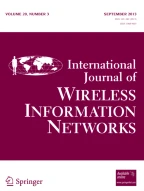Abstract
To make Wireless Sensor Network (WSN) market growth a reality, we need to empower the network designers with a provision to optimally tailor the physical layer parameters. In this paper, we present a holistic analysis of energy related aspects of WSN communications operating under Rayleigh fading, using standardized WSN specifications. The rational expressions have been derived by taking into consideration the effects of packet size, repeated training sequences, transmission distance, path-loss, amplifier efficiency, bandwidth of the channel and active mode span for Non-coherent M-ary FSK (NC-MFSK) and M-QAM modulation schemes. The results of variation of total energy consumption along with various parameters like path-loss, amplifier efficiency, hop distance and packet size have been investigated. We found that for small transmission distances, M-QAM modulation performs better than NC-MFSK scheme, but as the distance increases the NC-MFSK outperforms the M-QAM in the terms of energy efficiency. Moreover, for communications operating with NC-MFSK modulation, the crossover point of better energy efficiency is achieved at lesser distance with increase in value of path-loss parameter. These results may enable the network designers to plan energy-efficient WSN communication architectures even in the presence of constrained environments.
Similar content being viewed by others
References
R. Madan and S. Lall. Distributed algorithms for maximum lifetime routing in wireless sensor networks. Wireless Communications, IEEE Transactions on, 5(8):2185–2193, Aug 2006.
S. Amiri, H. Saidi, A. Ghiasian, and M.R. Hashemi. Enhanced lifetime maximization algorithm for wireless sensor network. pages 302–307, July 2011.
P. M. Shankar. Error rates in generalized shadowed fading channels. Wirel. Pers. Commun., 28(3):233–238, feb 2004.
Shuguang Cui, A.J. Goldsmith, and A Bahai. Energy-constrained modulation optimization. Wireless Communications, IEEE Transactions on, 4(5):2349–2360, Sept 2005.
P.S. Bithas, N.C. Sagias, P.T. Mathiopoulos, G.K. Karagiannidis, and A. Rontogiannis. On the performance analysis of digital communications over generalized-k fading channels. Communications Letters, IEEE, 10(5):353 – 355, may 2006.
Jyoteesh Malhotra, Ajay K. Sharma, and R S Kaler. On the performance analysis in composite multipath-shadowed fading wireless channel. International Journal of Computational Intelligence and Applications, 2(2), Jul-Dec 2008.
Nischay Bahl, Ajay K. Sharma, and Harsh K. Verma. Impact of physical layer jamming on wireless sensor networks with shadowing and multicasting. International Journal of Computer Network and Information Security, 4(7):51–56, Jun 2012.
Yurong Chen, Emin Gun Sirer, and S.B. Wicker. On selection of optimal transmission power for ad hoc networks. In System Sciences, 2003. Proceedings of the 36th Annual Hawaii International Conference on, pages 10 pp.–, Jan 2003.
J. Ammer and J. Rabaey. The energy-per-useful-bit metric for evaluating and optimizing sensor network physical layers. In Sensor and Ad Hoc Communications and Networks, 2006. SECON ’06. 2006 3rd Annual IEEE Communications Society on, volume 2, pages 695–700, Sept 2006.
S. Mukesh, M. Iqbal, Zhang Jianhua, Zhang Ping, and Inam-Ur-Rehman. Comparative analysis of m-ary modulation techniques for wireless ad-hoc networks. In Sensors Applications Symposium, 2007. SAS ’07. IEEE, pages 1–6, Feb 2007.
S. Chouhan, R. Bose, and M. Balakrishnan. Integrated energy analysis of error correcting codes and modulation for energy efficient wireless sensor nodes. Wireless Communications, IEEE Transactions on, 8(10):5348–5355, October 2009.
F.M. Costa and H. Ochiai. Energy optimization for reliable point-to-point communication in energy-constrained networks. In Vehicular Technology Conference (VTC 2010-Spring), 2010 IEEE 71st, pages 1–5, May 2010.
Jamshid Abouei, Konstantinos N. Plataniotis, and Subbarayan Pasupathy. Green modulations in energy-constrained wireless sensor networks. CoRR, abs/1008.3776, 2010.
Nischay Bahl, Ajay K. Sharma, and Harsh K. Verma. On the energy utilization for WSN based on BPSK over the Generalized-K shadowed fading channel. Wireless Networks, 20(8):2385–2393, 2014.
Nischay Bahl, AjayK. Sharma, and HarshK. Verma. On the energy utilization of WSN communications Using Space-Time Block Coding over BPSK and M-QAM modulations. International Journal of Wireless Information Networks, 22(3):180–187, 2015.
Matthew Holland, Tianqi Wang, Bulent Tavli, Alireza Seyedi, and Wendi Heinzelman. Optimizing physical-layer parameters for wireless sensor networks. ACM Trans. Sen. Netw., 7(4):28:1–28:20, February 2011.
Jaime Lloret, Sandra Sendra, Miguel Ardid, and Joel J. P. C. Rodrigues. Underwater wireless sensor communications in the 2.4 ghz ism frequency band. Sensors, 12:4237–4264, 2012.
U. Vilaipornsawai and M.R. Soleymani. A novel turbo coding scheme for satellite atm using reed-muller codes. Communications, IEEE Transactions on, 51(5):767 – 773, may 2003.
Mingoo Seok, Scott Hanson, Dennis Sylvester, and David Blaauw. Analysis and optimization of sleep modes in subthreshold circuit design. In Proceedings of the 44th Annual Design Automation Conference, DAC ’07, pages 694–699, New York, NY, USA, 2007. ACM.
F. Xiong. Digital Modulation Techniques. Artech House telecommunications library. Artech House, 2006.
J. Proakis and M. Salehi. Digital Communications. McGraw-Hill higher education. McGraw-Hill Education, 2007.
Author information
Authors and Affiliations
Corresponding author
Rights and permissions
About this article
Cite this article
Bahl, N., Sharma, A.K. & Verma, H.K. On the Energy Efficiency of WSN Communications Operating Under Non-coherent M-FSK and M-QAM Modulations. Int J Wireless Inf Networks 23, 222–230 (2016). https://doi.org/10.1007/s10776-016-0314-3
Received:
Accepted:
Published:
Issue Date:
DOI: https://doi.org/10.1007/s10776-016-0314-3
